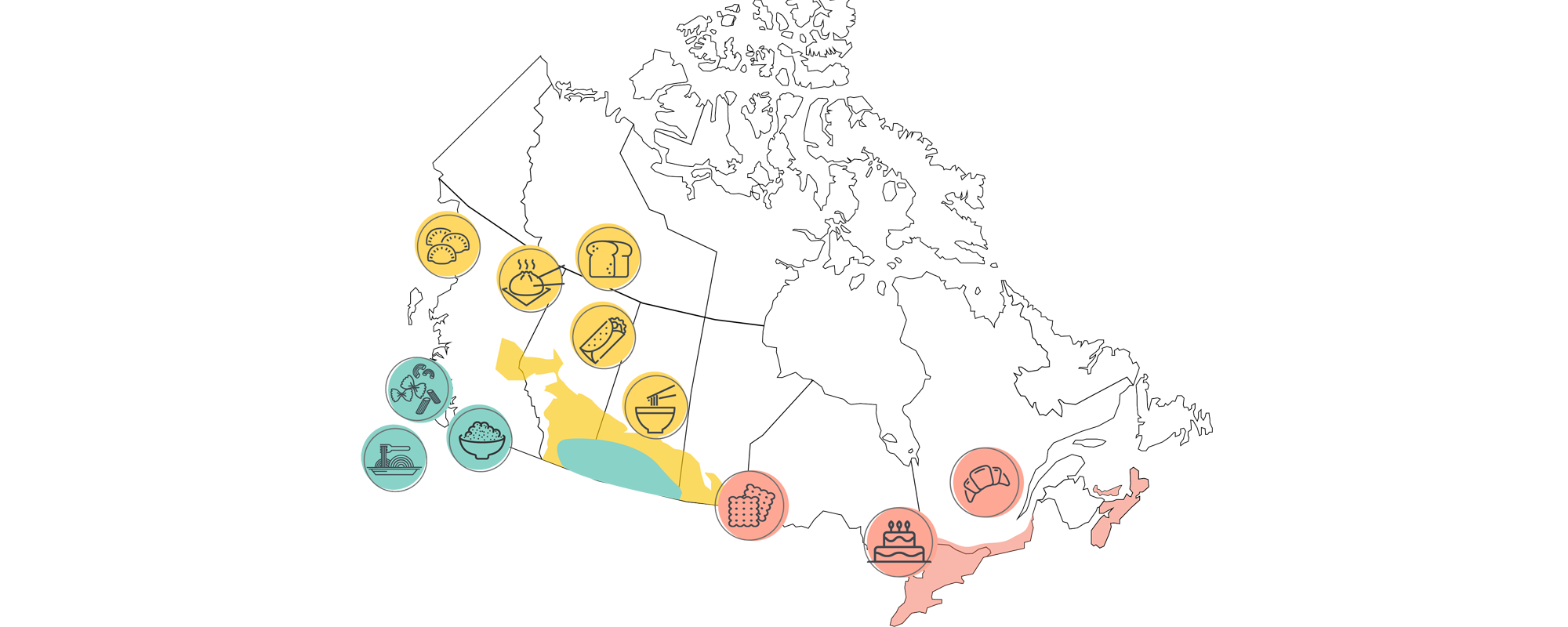Where is wheat grown?
Canada is the sixth4 largest wheat producer in the world. It’s grown on nearly 62,0005 grain and oilseed farms from coast to coast. Our vast, fertile country features various growing conditions that are ideal to produce various types of wheat.

Did you know?
The majority of wheat is grown on the Prairies, but you’ll also find wheat fields in British Columbia, Ontario, Quebec, Prince Edward Island and Nova Scotia. No matter where it is grown in the country, Canadian wheat is recognized for its quality, versatility, milling characteristics, and its superior performance in finished food products.
Farmers in Western Canada predominantly grow Canada Western Red Spring (CWRS) wheat, producing a high-protein content for superior milling, bread and noodle quality.
In Ontario, Quebec and the Atlantic provinces, farmers grow Canada Eastern Soft Red Winter (CESRW) wheat that is ideal for cakes, pastry, cereal, crackers and biscuits.
Canada is the world’s leading exporter of Canada Western Amber Durum (CWAD) wheat and it’s only grown in southern Alberta and Saskatchewan.

While Italy is known for its wine and France is famous for cheese, wheat is synonymous with Canada.
Canadian wheat goes worldwide

Today, Canada’s wheat harvest is about 30 million metric tonnes on average. Canadians love our wheat and consume a lot of it. But, we still grow about seven times more than what we can consume nationally and so much of it is exported.6 It’s sought after worldwide for its protein, quality and versatility. In fact, 20 million tonnes of Canadian wheat was exported in 2021,7 making its way to nearly every continent. Top export countries include the United States, Indonesia, Bangladesh, Peru, Japan and Italy.8
1 https://fas.usda.gov/data/production/commodity/0410000
2 https://graingrowers.ca/about-ggc/
3 https://cerealscanada.ca/production/
4 https://fas.usda.gov/data/production/commodity/0410000
5 https://graingrowers.ca/about-ggc/
6 Source: Average Production Over 6 Years Statistics Canada https://www150.statcan.gc.ca/t1/tbl1/en/tv.action?pid=3210035901
7 Canadian National Millers Association
8 Canadian International Merchandise Trade Database, Table 980-0010 and USDA FAS 2021 report https://www.fas.usda.gov/data/canada-grain-and-feed-update-21
9 Canadian National Millers Association
10 https://cerealscanada.ca/cereal-grains/wheat/
A long-standing tradition
Canada began earning its reputation as a leading producer and exporter of wheat hundreds of years ago. The first crop was planted in the 1600s with seed imported from Europe. Before long, the wheat harvest was more than enough needed to feed Canada’s population and the surplus seed flowed back to Europe.
The history of Canadian wheat is a success story – one of resourcefulness, adaptation, research, innovation and stewardship. Red Fife was the predominant variety grown in the 1800s, but Marquis was the first made-in-Canada wheat variety. Distributed to farmers in spring 1909, the seed quickly became popular because it matured faster, had excellent yield, and even better milling and baking qualities than varieties from Europe. Marquis was later adopted as the standard of quality for evaluating Canadian wheat varieties.9
Quality assurance
Not all wheat is the same and Canada has a very unique classification system on types or classes for wheat. Ten wheat classes are grown in Western Canada and seven in Eastern Canada.10 The most predominant are: Canada Western Red Spring (CWRS), Canada Western Amber Durum (CWAD), Canada Prairie Spring Red (CPSR) and Canada Eastern Soft Red Winter (CESRW). Within each class of wheat are multiple varieties with specific qualities and characteristics. Farmers will choose the wheat class and variety of wheat that grows best on their farm.
New wheat varieties take many years to be developed and evaluated for their individual characteristics of height, drought and cold tolerance, resistance to disease and pests, seed appearance and size, and milling and end-product (bread, pasta) quality. Varieties are evaluated in different wheat producing regions in Canada.
Each year, varieties are recommended for registration. This process called variety registration, is the foundation for the confidence that farmers, buyers, millers and other food manufacturers have in Canada’s wheat quality, and how it will perform when milled and used to create food products. Once varieties are registered, Canadian farmers can grow them in their fields.







